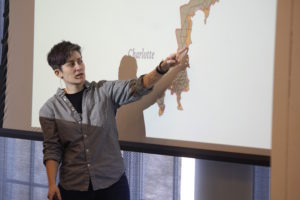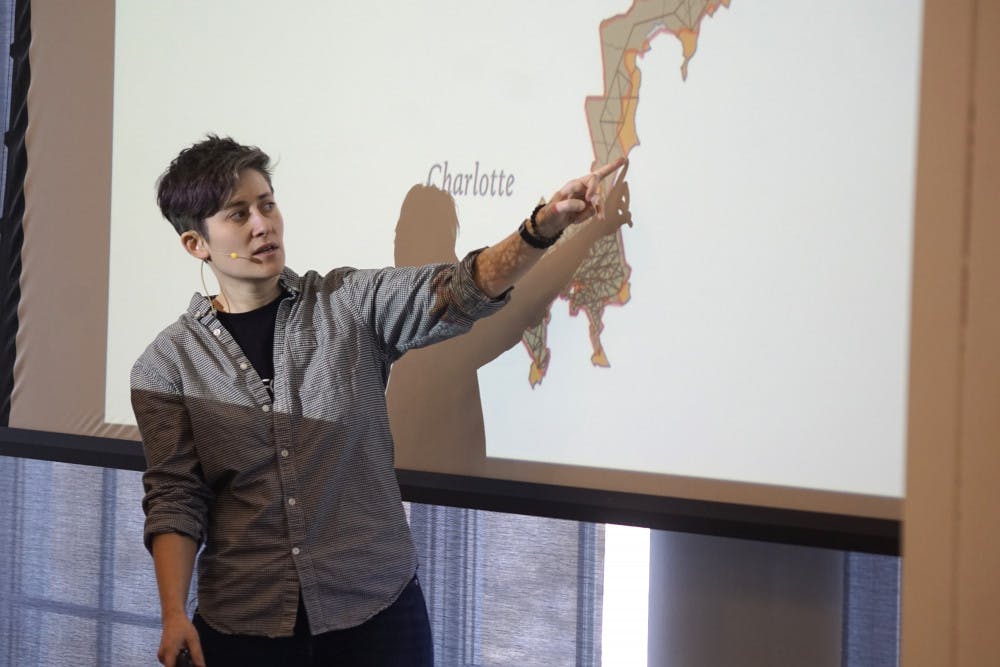By Ariel Steinsaltz
Staff Writer
The School of Science and the Department of Mathematics and Statistics presented a lecture by Moon Duchin, a mathematics professor at Tufts University, on the mathematics of gerrymandering, as part of the School of Science colloquium series on Feb. 27.
Duchin studies geometric group theory, geometric topology and the history and culture of science. She was recently hired by the state of Pennsylvania to help redraw its district lines.
Judit Kardus, an assistant professor in the Department of Mathematics and Statistics at the College brought in Duchin for the lecture, and said the College was fortunate to discover Duchin in an article about her in the Journal of Higher Education and invited her to speak before she was hired by Pennsylvania.
The term “gerrymandering” comes from Elbridge Gerry, a Massachusetts governor in the early 19th century, who manipulated district lines so that his party, the Democratic-Republicans, would win elections against the Federalists. The shape of one of his districts resembled salamander, which led to the name “gerrymander.”
Throughout U.S. history, just about every major political party has used this practice. Currently, Republicans, who control most of the state legislatures, have districts gerrymandered in their favor.
Duchin’s lecture stressed the power of the pen. Neutral boundaries — those which could be drawn by a computer — are not the same as fair boundaries, which take social justice issues into account.
“The ability to draw the boundaries has an enormous impact on the type of election outcomes that will occur,” Duchin said.

Duchin described the various factors that go into how districts are drawn, such as population equality and shape, as well as the various issues such as several lawsuits against districts that specifically gerrymander certain areas to disenfranchise minorities.
Duchin referenced Tuskegee, Alabama, as an example when in the mid-20th century, it became a district that went from 80 percent African-American to 100 percent white.
Duchin then explained how math could be used to help discover districts that are unfairly drawn. The Isoperimetric Theorem involves the relationship between area and perimeter. A circle is the way to maximize area in relation to perimeter, according to the theorem.
Districts that have a very small area-to-perimeter ratio are likely those that have been drawn unfairly in order to serve a political purpose.
Maps for districts are still drawn by hand despite the technology available because, according to Duchin, it would be impossible for a computer to fairly represent socio-geographic boundaries –– only humans have the capability to be socially just. What computers can do, though, is sample maps and determine likely election outcomes, and these statistics can help determine fairness and accuracy.
In response to a question from an audience member about why computers could not be used to draw district lines, Duchin replied that a computer could not be used to measure compliance with the Voting Rights Act.
Duchin explained that gerrymandering is a crime against democracy, and that a more objective algorithm for distinguishing between districts could and very well should be created.
“All the small choices you make shouldn’t be carefully chosen to advantage your side,” Duchin said.
Duchin became interested in the concept of gerrymandering “by teaching it,” and also through her “mathematical curiosity.” She came to lecture at the College to inspire others to become informed of the process of gerrymandering, and stressed the importance of mathematical outreach.
When asked why she chose to look at gerrymandering from both a mathematical and social lens, she said there was “no choice” — the topic simply required both.
Many students were excited about the lecture. Rebecca Conn, a junior math major, said that when she heard about the event she looked up Duchin, and was “super excited about the lecture.”
“I really liked the talk. She spoke about the math side of her work but explained everything that made it easy to understand,” she said after the event. “It was the first talk I’ve been to where I feel like I understood it.”







